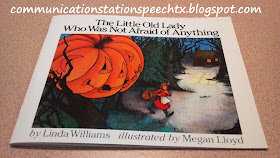If you are looking for your newest Tip Tuesday or FREEBIE Friday posts...head on over to my new website Communication Station: Speech Therapy and check it out!
Pages
▼
Thursday, September 26, 2013
Tuesday, September 24, 2013
Tip Tuesday: Using Big Block Singsong in speech therapy!
 |
| Photo Credit |
These shorts are colorful, fun, engaging animations that are only a few minutes long. Each short consists of a song that teaches young children about various age-appropriate topics. Depending on your student's cognitive level and language skills, I could see these animated clips being used for children PK-early elementary ages. You can find these cute "big" blocks singing about:
 |
| Photo Credit |
- animals
- body parts and senses
- being brave and trying new foods
- coping with feelings of anger
- other emotions such as happy and sad
- concepts of same vs. different
- fruits vs. vegetables (and healthy foods)
- occupations (magician, farmer, etc.)
- and so much more
How do I use Big Block Singsong for therapy?
1. First, I introduce the topic/theme
2. Then we watch the big block singsong animation that goes along with that theme
3. We talk about what we learned from big block singsong
4. Replay the clip and sing along (repetition)
Want to check it out for yourself? Here is a link to one of my personal favorite episodes on youtube: http://www.youtube.com/watch?v=TrwxTedNwCQ
The clips can be used to teach so many skills:
- categories (animals-farm/ocean/forest, foods-fruits/vegetables)
- time concepts (night/day)
- concepts (same/different)
- emotions (what they look like, what things might make us feel a certain way, how should be handle each emotion)
- social skills (trying new foods, coping with anger, meeting/making new friends, being friends with someone who is different than I am, etc.)
Have you ever used "Big Block Singsong" in your therapy? If so, how did you use it? Do you have any tips for us? Comment below!
Enjoy and happy singing and learning!!!

Friday, September 20, 2013
FREEBIE Friday: Recalling Sentences with increasing length!
I made this quick worksheet for one of my clients who has demonstrated some auditory recall and working memory issues in the past. After I read each sentence to my client with his eyes closed (he depends on visual input so much he gets distracted sometimes), I had my client visualize each scene. As each sentence expanded with information, I would ask my client to add those salient pieces of information to his visualization. Finally I would have him attempt to repeat the sentences after 1 repetition.
That is just one way to use the from. You can use this worksheet in many different ways and for students you suspect have ADP, auditory memory/recall difficulties, or for students who struggle to listen for key words.
Happy talking!!!!

Tuesday, September 17, 2013
Little Saint's PK: Alphabet Fun!
Alphabet Fun was the my son's home PK theme the past two weeks (with Labor day in there and taking a long weekend away this past weekend, it took us two weeks to do all the fun activities that went with our theme).
Here is a picture of some of the fun books we read about letters! My son is HUGE fan of the Alphabet Adventure/Mystery/Rescue books by Audrey and Bruce Wood (I purchased these via Scholastic books last year but you can get them on amazon as well if you are interested). I TOO love them! These books are great b/c they target the lower case alphabet (which I LOVE as most of the letters we write/type are actually lower case) in a fun adventurous story line for children. So if you are looking for some new alphabet books, I recommend checking these out!
In our book bin this week we has some older books as well. All were super fun to read and re-read!

Here is a picture of some of the fun books we read about letters! My son is HUGE fan of the Alphabet Adventure/Mystery/Rescue books by Audrey and Bruce Wood (I purchased these via Scholastic books last year but you can get them on amazon as well if you are interested). I TOO love them! These books are great b/c they target the lower case alphabet (which I LOVE as most of the letters we write/type are actually lower case) in a fun adventurous story line for children. So if you are looking for some new alphabet books, I recommend checking these out!
In our book bin this week we has some older books as well. All were super fun to read and re-read!
One thing I like to do with my son is read each book first, then re-read it and we discuss what sound each letter makes and think of words or find pictures of in each book that begin with that sound. Finally, we spent some time tracing the capital and lower case letters in the book "Eating the Alphabet" by Lois Ehlert. Isn't that little chubby hand so cute?! I love my son's little fingers!!!
We of course read our daily scripture (for those of you who missed my first installment of this PK program you can read all about it here) and discussed the lesson emphasis each day. The emphasis was basically that we speak in words and words are made up of letters. Some other fun activities we did were:
Name letter sequencing:
As you can see I wrote each letter of my son's name on a fish card and he used his name tag to put the letters in the correct sequence. He was a proud by when he was finished! :)
Chicka Chicka Boom, Boom! and art project:
The letters are climbing up the coconut tree! We talked about each letter and the sound it made as he stuck each sticker on the "tree"!
My son tried very hard to cut out the coconuts along the circular line! Great practice for fine motor skills!
We added our palm tree leaves and voila'...our coconut tree is complete!
Alphabet Soup:
We made some alphabet soup simply by scooping up each letter and matching it to the correct letter in the bowl.
B/c we are incorporating religion at home, we made alphabet soup for the family and God, Mary, and Jesus.
Add some veggies and a spoon and we've got ourselves some alphabet soup! Almost good enough to eat!
By the way, after we were done with our alphabet soup we spent some time playing rhyming games with these names. Remember the name game song? Well that's what we did! "Mommy, mommy, bo, bommy, banana, fanana, fo, fommy, fe, fi, fo, fommy, Mommy!" Great for early literacy skills!
Our Names in HIS book:
We talked about how God made each of us special and that our names are written in His book in heaven just waiting for use to come home. I used some pipe cleaners to make each letter and my son had to match them up to his name!
Initial's fun:
My son used glue and scrap paper to make his initials! We had to discuss what initials actually were and how his looks different from mommy's and daddy's initials b/c our names are different.
Magnet letters and tracing:
This was a cool activity I saw somewhere before...maybe on Pinterest. I can't exactly recall but it was NOT my original idea. My son used some magnetic letters and a highlighter to spell out and trace our names! (p.s. the F letter was one of the extra letters he had to choose from a mix to spell his name. He of course did not choose any letters that did no belong in his name but I didn't move it before I took this pic...oops!)
Sidebar: Boy activity:
My boys worked hard repainting my son's train table first with magnetic pain, then with dry erase board paint so we can NOW draw, write, and stick magnets to the bottom of his train table. Oh what fun we will be having in the future! Well done boys! the table looks great!!!
So that was our last two weeks in a nutshell. You can see how language as well as phonemic and phonetic awareness was incorporated into almost every activity this week! All of these activities are easily adapted for your own home practice or for speech therapy. Next week I'll share with you the fun activities we are doing this week as we learn about our 5 senses!
Happy talking and learning!

Friday, September 13, 2013
FREEBIE Friday!: Before/After Events
A few weeks ago I wrote a guest blog on School House Talk's blog about how I target Before/After Directions. This week, I have an activity to teach what "before/after" means when placed these words in the beginning and middle of a sentence or direction. Below is an activity I made for one of my clients where we cut out and placed before and after in the blanks and labeled which even happened first and second. I chose to use events that are NOT logical in nature so a student will really have to focus on how "before/after" actually change the meaning of each statement.
Check it out below and grab your freebie HERE!

Check it out below and grab your freebie HERE!
Enjoy and happy talking!

Tuesday, September 10, 2013
Tip Tuesday: Halloween Themed Books You CAN Read in Schools!
Working in the public school system is always a challenge when it come to holidays. As speech pathologists we want to talk about the appropriate vocabulary and culturally appropriate experiences children participate within their homes and communities. However, in this day and age, political correctness (and in my humble opinion over sensitivity to these matters) many times ties our hands and we are stuck with discussing "fall harvest" rather than Halloween. I don't know about you, but teaching my students with ASD how to knock on someone's door, and appropriately say "trick or treat" and "thank you" is so much more functional than talking about scarecrows and corn mazes. I, of course, believe we need to respect others' beliefs, but I feel all of this can be balanced better in a more tolerable nature than what we current have. With that said, I am one person and cannot change the laws or district policies out there for many of you. BUT, I can try and give you an alternative way to discuss much of that same vocabulary via books that are "Halloween" themed without any mention of Halloween.
So, here are my go to books when I cannot discuss "Halloween" but I still want my students to come away with real culturally appropriate vocabulary:

So, here are my go to books when I cannot discuss "Halloween" but I still want my students to come away with real culturally appropriate vocabulary:
The Legend of Spookley the Square Pumpkin: I LOVE this book for the fall season! (You WILL see this again in October...hint, hint...there's a Freebie Friday post with Spookley's name on it) This book has a great moral message about accepting others even when they are different than us. And of course a square pumpkin is super cute too!
The Little Old Lady Who Was Not Afraid of Anything: Who doesn't love this book???? Oh the actions, sound words, repetition, sequencing activities that can be done just by reading this fun little book about a very brave old lady!
I Spy Pumpkins: You know I love my "I Spy" books from my previous post (if you haven't read it, you can check that post out here). This is no exception. Looks creepy from the outside, but children with have lots of fun trying to spy some pumpkins in the midst of these "busy" pictures!
The Pumpkin Mystery: This book is a great chapter book. It's simple but discusses how we plant and harvest pumpkins disguised in a fun, kid-friendly "mystery". Great for predicting and inferencing as well as for retelling, discussing main idea, etc.
Five Little Bats Flying in the Night: This book is just like the 5 little Monkeys book but super fun for the fall! These silly bats will keep young children entertained while incorporating language and math in one!
Where's My Mummy?: This a sweet book about a baby Mummy who's looking for his mama. Of course you meet a few crazy characters (e.g. skeleton, vampire, etc.) along the way who teach us all about bedtime routine and in the end, our baby finds his mama!
Of course we can't forget Eric Carle's The Very Busy Spider!: Last year I wrote a few posts about using a spider theme in therapy and creating a human spider web. You can check them out here and here if you missed them!
The Spider and the Fly: I also like to use this book (my picture did not come out well on my camera so I had to use a pic from amazon) for my older students. It's actually a poem about a Spider who tricks a fly to come into his "parlor" and he of course eats her. It is a bit dark, but my older students love to look at the illustrations and make predictions as to whether this fly will be fooled by the spider. This book is also good for my students with ASD as the spider says he wants the fly to come in for one reason or another, but of course that is not true. I like to teach my students to "listen to the spider's voice" (as I read it in a "creepy" voice) and see if they can really figure out why the spider wants the fly to come inside. Sometimes it takes a while for our literal kiddos to really understand the true meaning of the spiders words.
Ok so that is my list of books you CAN read in the schools. You CAN discuss some really great culturally relevant vocabulary while skirting around the idea of "Halloween" and still teach some great language skills!
What do you think of my list? What are your favorite "Halloween" themed books you CAN read in school? Share below so we may all benefit!
Enjoy and happy talking!

Friday, September 6, 2013
FREEBIE Friday: Vocal Abuse Behavior Checklist
Here's my Vocal Abuse Behaviors Checklist. Check it out below and download it via Google documents here!
P.S. I like to save a few trees by printing front to back and my files are much thinner that way! :)
Enjoy!

Tuesday, September 3, 2013
Tip Tuesday! Let's Talk About Voice Disorders!

We as parents are so used to hearing our children screech out in excitement or cry out in frustration that we tend to forget that this type of vocal abuse can cause our children to have voice disorders.
What is a Voice Disorder?
A voice disorder is defined as an abnormality in at least one of the following: vocal quality (resonance, e.g. nasal or hyponasal), vocal pitch, and vocal intensity (volume level).
What causes a voice disorder?
A voice disorder can be caused by a number of things:
- Vocal abuse over a period of time which caused growths on one's vocal cords (known as vocal nodules or polyps).
- Vocal cord (also called vocal fold) movement difficulties due to
- vocal fold paralysis,
- spasmodic dysphonia (when vocal cord movement is tight, jerky, and there are vocal cord spasms with periods of aphonia-lack of voicing),
- paradoxical vocal fold movement (when vocal cords close when they should be open).
- Most child voice disorders are caused by vocal abuse so let's explore that further.
Vocal Abuse can be caused by numerous behaviors. Here are some more common causes:
- Excessive Screaming
- Excessive Yelling/Shouting
- Excessive Crying
- Cheering (at sports events)
- Singing
- Chronic use of a higher pitch than typical
- Chronic use of louder volume than typical
- Chronic coughing due to colds
- Chronic post-nasal drip due to allergies
- Chronic medical illnesses that affect the throat area (ex. laryngitis, strep throat, etc.)
- Inadequate breath support (not using diaphragmatic breathing)
- rough/hoarse voice
- breathy voice
- scratchy voice
- harshness in vocal quality
- decreased pitch and volume range
- difficulty sustaining voice and difficulty singing
- moments of aphonia (i.e. unable to achieve voice)
- Discuss your concerns with your pediatrician and contact an ENT (Ear, Nose and Throat doctor) or Otolaryngologist to determine if there is a medical reason for your child's vocal disturbances (structural damage vs. vocal cord movement problems)
- Then contact a Speech-Language Pathologist so your child can participate in voice therapy. **Keep in mind speech therapy will be MOST effective when the SLP knows the underlying cause (i.e. structural damage or other medical issues) and how your child's vocal cords are moving. This can only be determined by the ENT/Otolaryngologist evaluation.**
Voice therapy consists of teaching your child the optimal ways of using their vocal quality (resonance), pitch and intensity (volume). It focuses on reducing abusive behaviors, while improving healthy vocal cord behaviors (e.g. proper hydration, use of proper breath support, etc.). Voice therapy has been found to be very effective in reducing voice disorders and improving vocal quality.
For further information on Voice Disorders go to American-Speech-Hearing and Language Association website.
If you are concerned about your child's voice, don't hesitate to contact a local Speech-Language Pathologist for a consultation.
Happy Talking!


























